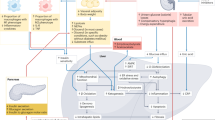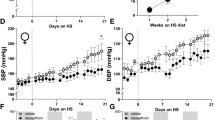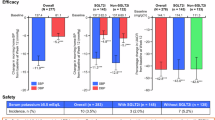Abstract
We previously demonstrated that combining a sodium–glucose cotransporter 2 (SGLT2) inhibitor with diuretics significantly reduces interstitial fluid volume without excessive depletion of circulating plasma volume or activation of the renin–angiotensin–aldosterone system (RAAS). However, the differential effects of SGLT2 inhibitor monotherapy versus combination therapy with diuretics on fluid dynamics in patients with pre-existing fluid retention remain unclear. This study included patients with fluid retention, defined by an extracellular water to total body water (ECW/TBW) ratio > 0.400, as measured by bioimpedance analysis. We evaluated 6-month changes in body fluid status and serum copeptin levels, a surrogate marker for vasopressin, between two groups: patients receiving SGLT2 inhibitor dapagliflozin monotherapy (SGLT2i group, n = 13; estimated glomerular filtration rate [eGFR] 25.0 ± 8.5 mL/min/1.73 m2) and those receiving dapagliflozin in combination with loop or thiazide diuretics (SGLT2i + diuretic group, n = 18; eGFR 29.8 ± 15.2 mL/min/1.73 m2). Changes in systolic blood pressure and estimated plasma volume did not significantly differ between groups. However, reductions in ECW/TBW, TBW, and interstitial fluid were significantly greater in the combination group than in the monotherapy group. Moreover, the increase in serum copeptin was significantly suppressed in the SGLT2i + diuretic group. No significant intergroup differences were observed in renin and aldosterone changes. These findings suggest that co-administration of SGLT2 inhibitor with diuretics can more effectively reduce interstitial fluid retention without inducing excessive plasma volume reduction or RAAS activation.

This is a preview of subscription content, access via your institution
Access options
Subscribe to this journal
Receive 12 print issues and online access
$259.00 per year
only $21.58 per issue
Buy this article
- Purchase on SpringerLink
- Instant access to full article PDF
Prices may be subject to local taxes which are calculated during checkout





Similar content being viewed by others
References
Vallon V. How can inhibition of glucose and sodium transport in the early proximal tubule protect the cardiorenal system? Nephrol Dial Transpl. 2024;39:1565–73.
Rieg T, Masuda T, Gerasimova M, Mayoux E, Platt K, Powell DR, et al. Increase in SGLT1-mediated transport explains renal glucose reabsorption during genetic and pharmacological SGLT2 inhibition in euglycemia. Am J Physiol Ren Physiol. 2014;306:F188–93.
Nuffield Department of Population Health Renal Studies G, Consortium SiM-AC-RT. Impact of diabetes on the effects of sodium glucose co-transporter-2 inhibitors on kidney outcomes: collaborative meta-analysis of large placebo-controlled trials. Lancet. 2022;400:1788–801.
Masuda T, Nagata D. Fluid homeostasis induced by sodium-glucose cotransporter 2 inhibitors: novel insight for better cardio-renal outcomes in chronic kidney disease. Hypertens Res. 2023;46:1195–201.
Hallow KM, Helmlinger G, Greasley PJ, McMurray JJV, Boulton DW. Why do SGLT2 inhibitors reduce heart failure hospitalization? A differential volume regulation hypothesis. Diab Obes Metab. 2018;20:479–87.
Asakura-Kinoshita M, Masuda T, Oka K, Ohara K, Miura M, Morinari M, et al. Sodium-glucose cotransporter 2 inhibitor combined with conventional diuretics ameliorate body fluid retention without excessive plasma volume reduction. Diagnostics. 2024;14.
Masuda T, Yoshida M, Onaka T, Nagata D. Water and sodium conservation response induced by SGLT2 inhibitor ipragliflozin in Dahl salt-sensitive hypertensive rats. Hypertens Res. 2024;47:3173–81.
Masuda T, Watanabe Y, Fukuda K, Watanabe M, Onishi A, Ohara K, et al. Unmasking a sustained negative effect of SGLT2 inhibition on body fluid volume in the rat. Am J Physiol Ren Physiol. 2018;315:F653–64.
Masuda T, Ohara K, Murakami T, Imai T, Nakagawa S, Okada M, et al. Sodium-glucose cotransporter 2 inhibition with dapagliflozin ameliorates extracellular volume expansion in diabetic kidney disease patients. POJ Diab Obes. 2017;1:1–8.
Masuda T, Ohara K, Vallon V, Nagata D. SGLT2 inhibitor and loop diuretic induce different vasopressin and fluid homeostatic responses in nondiabetic rats. Am J Physiol Ren Physiol. 2022;323:F361–69.
Masuda T, Muto S, Fukuda K, Watanabe M, Ohara K, Koepsell H, et al. Osmotic diuresis by SGLT2 inhibition stimulates vasopressin-induced water reabsorption to maintain body fluid volume. Physiol Rep. 2020;8:e14360.
Oka K, Masuda T, Ohara K, Miura M, Morinari M, Misawa K, et al. Fluid homeostatic action of dapagliflozin in patients with chronic kidney disease: the DAPA-BODY Trial. Front Med (Lausanne). 2023;10:1287066.
Ohara K, Masuda T, Morinari M, Okada M, Miki A, Nakagawa S, et al. The extracellular volume status predicts body fluid response to SGLT2 inhibitor dapagliflozin in diabetic kidney disease. Diabetol Metab Syndr. 2020;12:37.
Hung SC, Lai YS, Kuo KL, Tarng DC. Volume overload and adverse outcomes in chronic kidney disease: clinical observational and animal studies. J Am Heart Assoc 2015;4.
Tai R, Ohashi Y, Mizuiri S, Aikawa A, Sakai K. Association between ratio of measured extracellular volume to expected body fluid volume and renal outcomes in patients with chronic kidney disease: a retrospective single-center cohort study. BMC Nephrol. 2014;15:189.
Tsai YC, Tsai JC, Chen SC, Chiu YW, Hwang SJ, Hung CC, et al. Association of fluid overload with kidney disease progression in advanced CKD: a prospective cohort study. Am J Kidney Dis. 2014;63:68–75.
Kanbay M, Yilmaz S, Dincer N, Ortiz A, Sag AA, Covic A, et al. Antidiuretic hormone and serum osmolarity physiology and related outcomes: What Is Old, What Is New, and What Is Unknown? J Clin Endocrinol Metab. 2019;104:5406–20.
Morgenthaler NG, Struck J, Alonso C, Bergmann A. Assay for the measurement of copeptin, a stable peptide derived from the precursor of vasopressin. Clin Chem. 2006;52:112–9.
Scholtes RA, Muskiet MHA, van Baar MJB, Hesp AC, Greasley PJ, Hammarstedt A, et al. The adaptive renal response for volume homeostasis during 2 weeks of dapagliflozin treatment in people with type 2 diabetes and preserved renal function on a sodium-controlled diet. Kidney Int Rep. 2022;7:1084–92.
Berton AM, Parasiliti-Caprino M, Prencipe N, Bioletto F, Lopez C, Bona C, et al. Copeptin adaptive response to SGLT2 inhibitors in patients with type 2 diabetes mellitus: The GliRACo study. Front Neurosci. 2023;17:1098404.
Huang X, Dorhout Mees E, Vos P, Hamza S, Braam B. Everything we always wanted to know about furosemide but were afraid to ask. Am J Physiol Ren Physiol. 2016;310:F958–71.
Channavajjhala SK, Bramley R, Peltz T, Oosthuyzen W, Jia W, Kinnear S, et al. Urinary extracellular vesicle protein profiling and endogenous lithium clearance support excessive renal sodium wasting and water reabsorption in thiazide-induced hyponatremia. Kidney Int Rep. 2019;4:139–47.
InBody Co., Ltd. InBody S10 User’s manual. 2015.
Kim CR, Shin JH, Hwang JH, Kim SH. Monitoring volume status using bioelectrical impedance analysis in chronic hemodialysis patients. ASAIO J. 2018;64:245–52.
Zheng K, Lu J, Liu X, Ji W, Liu P, Cui J, et al. The clinical application value of the extracellular-water-to-total-body-water ratio obtained by bioelectrical impedance analysis in people with advanced cancer. Nutrition. 2022;96:111567.
Heerspink HJL, Stefansson BV, Correa-Rotter R, Chertow GM, Greene T, Hou FF, et al. Dapagliflozin in patients with chronic kidney disease. N Engl J Med. 2020;383:1436–46.
Wheeler DC, Toto RD, Stefansson BV, Jongs N, Chertow GM, Greene T, et al. A pre-specified analysis of the DAPA-CKD trial demonstrates the effects of dapagliflozin on major adverse kidney events in patients with IgA nephropathy. Kidney Int. 2021;100:215–24.
Matsuo S, Imai E, Horio M, Yasuda Y, Tomita K, Nitta K, et al. Revised equations for estimated GFR from serum creatinine in Japan. Am J Kidney Dis. 2009;53:982–92.
Flannery AH, Ortiz-Soriano V, Li X, Gianella FG, Toto RD, Moe OW, et al. Serum renin and major adverse kidney events in critically ill patients: a multicenter prospective study. Crit Care. 2021;25:294.
Rieder M, Wirth L, Pollmeier L, Jeserich M, Goller I, Baldus N, et al. Serum ACE2, angiotensin II, and aldosterone levels are unchanged in patients with COVID-19. Am J Hypertens. 2021;34:278–81.
Strauss MB, Davis RK, Rosenbaum JD, Rossmeisl EC. Water diuresis produced during recumbency by the intravenous infusion of isotonic saline solution. J Clin Invest. 1951;30:862–8.
Kaplan AA. A simple and accurate method for prescribing plasma exchange. ASAIO Trans. 1990;36:M597–99.
Retzlaff JA, Tauxe WN, Kiely JM, Stroebel CF. Erythrocyte volume, plasma volume, and lean body mass in adult men and women. Blood. 1969;33:649–61.
Ohara K, Masuda T, Murakami T, Imai T, Yoshizawa H, Nakagawa S, et al. Effects of the sodium-glucose cotransporter 2 inhibitor dapagliflozin on fluid distribution: a comparison study with furosemide and tolvaptan. Nephrology. 2019;24:904–11.
Masuda T, Ohara K, Nagayama I, Matsuoka R, Murakami T, Nakagawa S, et al. Impact of serum albumin levels on the body fluid response to tolvaptan in chronic kidney disease patients. Int Urol Nephrol. 2019;51:1623–9.
Durante W, Behnammanesh G, Peyton KJ. Effects of sodium-glucose co-transporter 2 inhibitors on vascular cell function and arterial remodeling. Int J Mol Sci 2021; 22.
Herat LY, Magno AL, Rudnicka C, Hricova J, Carnagarin R, Ward NC, et al. SGLT2 inhibitor-induced sympathoinhibition. A Nov Mechanism Cardiorenal Prot JACC Basic Transl Sci. 2020;5:169–79.
Sugiyama S, Jinnouchi H, Kurinami N, Hieshima K, Yoshida A, Jinnouchi K, et al. The SGLT2 inhibitor dapagliflozin significantly improves the peripheral microvascular endothelial function in patients with uncontrolled type 2 diabetes mellitus. Intern Med. 2018;57:2147–56.
Packer M. SGLT2 inhibition: neither a diuretic nor a natriuretic. J Am Coll Cardiol. 2024;83:1399–402.
Marton A, Saffari SE, Rauh M, Sun RN, Nagel AM, Linz P, et al. Water conservation overrides osmotic diuresis during SGLT2 inhibition in patients with heart failure. J Am Coll Cardiol. 2024;83:1386–98.
Onishi A, Fu Y, Patel R, Darshi M, Crespo-Masip M, Huang W, et al. A role for tubular Na(+)/H(+) exchanger NHE3 in the natriuretic effect of the SGLT2 inhibitor empagliflozin. Am J Physiol Ren Physiol. 2020;319:F712–28.
Kario K, Hoshide S, Mogi M. Hypertension treatment up-date on World Hypertension Day 2024: current status and future prospects in Asia. Hypertens Res. 2024;47:1763–5.
Acknowledgements
The authors acknowledge the data entry support of Naoko Ishikawa and the technical support provided by the clinical engineers at the Shin-Oyama City Hospital and Nasu Minami Hospital. We thank Shinji Asakura (Oyama Suginoki Clinic) for his critical comments and support, as well as the laboratory technicians at Jichi Medical University, Shin-Oyama City Hospital, and Nasu Minami Hospital. We also thank Editage (www.editage.jp) for English language editing.
Funding
This research was supported by the Kidney Foundation, Japan (Grant number JKFB21-18 to TM) and the Jichi Medical University Young Investigator Awards (to TM and KOh).
Author information
Authors and Affiliations
Contributions
Conceptualization: TM and MAK; Data curation: TM, KOk, KOh, MMi and MMo; Formal analysis: TM, MAK, and KOk; Investigation: TM, MAK, and KOk; Writing—original draft: TM; Writing—review and editing: MAK, KOk, KOh, MS, MMi, KM, MS, MM, KH, TA, KS, DS, and YM; Funding acquisition: TM and KOh; Validation: KH, TA, KS, DN and YM. All authors have read and approved the final version of the manuscript.
Corresponding author
Ethics declarations
Conflict of interest
The authors declare no competing interests.
Additional information
Publisher’s note Springer Nature remains neutral with regard to jurisdictional claims in published maps and institutional affiliations.
Rights and permissions
Springer Nature or its licensor (e.g. a society or other partner) holds exclusive rights to this article under a publishing agreement with the author(s) or other rightsholder(s); author self-archiving of the accepted manuscript version of this article is solely governed by the terms of such publishing agreement and applicable law.
About this article
Cite this article
Masuda, T., Asakura-Kinoshita, M., Oka, K. et al. SGLT2 inhibitor requires co-administration with diuretics to effectively reduce interstitial fluid retention: the DAPA-BODY trial. Hypertens Res (2025). https://doi.org/10.1038/s41440-025-02388-5
Received:
Revised:
Accepted:
Published:
DOI: https://doi.org/10.1038/s41440-025-02388-5



